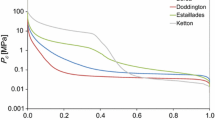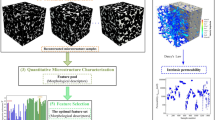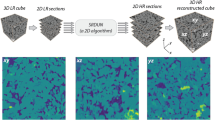Abstract
Typical geological systems are composed of a broad spectrum of porous media with regionalized rock properties such as porosity or permeability varying by orders of magnitude within a volume of study. Upscaling the petrophysical rock properties is controlled by the rock pore size and type heterogeneity, which is a scale-dependent variable. At the same time, recent advances in high-resolution imaging techniques have provided a wealth of 2D and 3D datasets that reveal the microstructure of rocks and soil on scales ranging from nanometres to centimetres. However, the images can vary greatly based on the imaging technique and research objective. Automating the rock heterogeneity estimation, regardless of the type of imaged input, would greatly interest geology and engineering communities. It can save the time spent in investigating the rock fabric and evaluating the rock heterogeneity, based on expertise. Hence, it would provide a fast priori-information tool for further investigation and uncertainty analysis of geological and engineering models built on that rock. We provide an automatic scale-independent method for classifying rock heterogeneity. Our method modifies local order metrics by Torquato et al. (J Phys Math Theor 55:274003, 2022. https://doi.org/10.1088/1751-8121/ac72d7). They used synthetic, two-phase porous materials and compared the relative disorder ranking for materials with the same length scale and porosity. Our modification introduces length scale independence and was verified against three categories of benchmarks consisting of 87 geologic and synthetic 3D computed tomography (CT) datasets found on the Digital Rocks Portal (https://www.digitalrocksportal.org/). Further, the method performs better than other geostatistical heterogeneity coefficients, including Dykstra–Parsons, Lorenz, and pore heterogeneity coefficients. A sensitivity analysis has revealed significantly faster performance and greater reliability when evaluating true heterogeneity in 3D compared to the apparent heterogeneity seen when splitting 3D volume in its 2D cross section. Thus, whenever possible, 3D datasets should be used to analyze porous media. While we apply this to the images in Digital Rocks Portal in the hopes that it will ease automated curation of images in the future, the method should extend easily to any porous media images.
Article Highlights
-
Heterogeneity of digital rock images can be detected regardless of the length scale in a wide variety of benchmark images from Digital Rocks Portal
-
The scale-independent variance algorithm is developed, including defining heterogeneity/homogeneity threshold
-
The scale-independent variance algorithm can be modified to evaluate the heterogeneity of the spatial distribution of rock properties (e.g., porosity, permeability, etc.) in both 2D and 3D images. We find strong evidence to use 3D images for characterization if at all possible.
























Similar content being viewed by others
Data Availability
The datasets generated or analyzed in the current study are available in the cited references or can be obtained from the corresponding author on reasonable request. The algorithm's Python code can also be accessed through the GitHub link https://github.com/PG-Ali-E-Mohamed/Heterogeneity_classifier.
References
Andrä, H., Combaret, N., Dvorkin, J., Glatt, E., Han, J., Kabel, M., Keehm, Y., Krzikalla, F., Lee, M., Madonna, C., Marsh, M., Mukerji, T., Saenger, E.H., Sain, R., Saxena, N., Ricker, S., Wiegmann, A., Zhan, X.: Digital Rock Physics Benchmarks—Part I: Imaging and Segmentation. Comput. Geosci. (2013)
Armstrong, R.T., McClure, J.E., Robins, V., Liu, Z., Arns, C.H., Schlüter, S., Berg, S.: Porous media characterization using minkowski functionals: theories, applications and future directions. Transp. Porous Media 130, 305–335 (2019). https://doi.org/10.1007/s11242-018-1201-4
Armstrong, R., Mostaghimi, P.: Moura coal. (2017) https://doi.org/10.17612/P7V888
Bisong, E.: Google colaboratory. In: Bisong, E. (Ed.), Building machine learning and deep learning models on google cloud platform: a comprehensive guide for beginners. Apress, Berkeley, CA, pp. 59–64 (2019). https://doi.org/10.1007/978-1-4842-4470-8_7
Bultreys, T., De Boever, W., Cnudde, V.: Imaging and image-based fluid transport modeling at the pore scale in geological materials: a practical introduction to the current state-of-the-art. Earth-Sci. Rev. 155, 93–128 (2016). https://doi.org/10.1016/j.earscirev.2016.02.001
College, I.: Imperial college consortium on pore-scale modelling. Berea Sandstone (2014). https://doi.org/10.6084/m9.figshare.1153794.v2
De Boever, W., Diaz, A., Derluyn, H., De Kock, T., Van Stappen, J., Dewanckele, J., Bultreys, T., Boone, M., De Schryver, T., Skjønsfjell, E.T.B., Holler, M., Breiby, D.W., Cnudde, V.: Characterization of composition and structure of clay minerals in sandstone with ptychographic X-ray nanotomography. Appl. Clay Sci. 118, 258–264 (2015). https://doi.org/10.1016/j.clay.2015.09.020
Dykstra, H., Parsons, R.: The prediction of oil recovery by water flood. Second. Recov. Oil u. s. 2, 160–174 (1950)
Elkateb, T., Chalaturnyk, R., Robertson, P.K.: An overview of soil heterogeneity: quantification and implications on geotechnical field problems. Can. Geotech. J. 40, 1–15 (2003). https://doi.org/10.1139/t02-090
Fitch, P., Davies, S., Lovell, M., Pritchard, T.: Reservoir quality and reservoir heterogeneity: petrophysical application of the Lorenz coefficient. Petrophysics 54, 465–474 (2013)
Fitch, P.J.R., Lovell, M.A., Davies, S.J., Pritchard, T., Harvey, P.K.: An integrated and quantitative approach to petrophysical heterogeneity. Mar. Pet. Geol. 63, 82–96 (2015). https://doi.org/10.1016/j.marpetgeo.2015.02.014
Frash, L., Carey, B.: Triaxial direct-shear in situ microtomography (2018)
Gostick, J., Khan, Z., Tranter, T., Kok, M., Agnaou, M., Sadeghi, M., Jervis, R.: PoreSpy: a python toolkit for quantitative analysis of porous media images. J. Open Source Softw. 4, 1296 (2019). https://doi.org/10.21105/joss.01296
Gostick, J.T.: Versatile and efficient pore network extraction method using marker-based watershed segmentation. Phys. Rev. E 96, 023307 (2017). https://doi.org/10.1103/PhysRevE.96.023307
Holler, M., Diaz, A., Guizar-Sicairos, M., Karvinen, P., Färm, E., Härkönen, E., Ritala, M., Menzel, A., Raabe, J., Bunk, O.: X-ray ptychographic computed tomography at 16 nm isotropic 3D resolution. Sci. Rep. 4, 3857 (2014). https://doi.org/10.1038/srep03857
Iassonov, P., Gebrenegus, T., Tuller, M.: Segmentation of X-ray computed tomography images of porous materials: a crucial step for characterization and quantitative analysis of pore structures. Water Resour. Res. (2009). https://doi.org/10.1029/2009WR008087
Jensen, J., Lake, L.W., Corbett, P.W.M., Goggin, D.: Statistics for Petroleum Engineers and Geoscientists. Gulf Professional Publishing, Houston (2000)
Karpyn, Z., Landry, C., Prodanovic, M.: Induced rough fracture in Berea sandstone core (2016) https://doi.org/10.17612/P7J012
Lorenz, M.O.: Methods of measuring the concentration of wealth. Publ. Am. Stat. Assoc. 9, 209–219 (1905). https://doi.org/10.2307/2276207
Marafini, E., La Rocca, M., Fiori, A., Battiato, I., Prestininzi, P.: Suitability of 2D modelling to evaluate flow properties in 3D porous media. Transp. Porous Media 134, 315–329 (2020). https://doi.org/10.1007/s11242-020-01447-4
Maschio, C., Schiozer, D.J.: A new upscaling technique based on Dykstra-Parsons coefficient: evaluation with streamline reservoir simulation. J. Pet. Sci. Eng. 40, 27–36 (2003). https://doi.org/10.1016/S0920-4105(03)00060-3
Mehmani, A., Verma, R., Prodanović, M.: Pore-scale modeling of carbonates. Mar. Pet. Geol. 114, 104141 (2020). https://doi.org/10.1016/j.marpetgeo.2019.104141
Pérez-Díaz, L., Alcalde, J., Bond, C.E.: Introduction: Handling uncertainty in the geosciences: identification, mitigation and communication. Solid Earth 11, 889–897 (2020). https://doi.org/10.5194/se-11-889-2020
Prodanovic, M., Esteva, M., Hanlon, M., Nanda, G., Agarwal, P.: Digital Rocks Portal [WWW Document] (2015) https://doi.org/10.17612/P7CC7K
Prodanovic, M., Landry, C., Tokan-Lawal, A., Eichhubl, P., Niobrara formation fracture (2016) https://doi.org/10.17612/P7SG6Z
Prodanovic, M., Esteva, M., McClure, J.E., Chang, B.C., Santos, J.E., Radhakrishnan, A., Singh, A., Khan, H.: Digital rocks portal (Digital Porous Media): connecting data, simulation and community. In: Society of Core Analysts Symposium Proceedings. Presented at the Society of Core Analysts Symposium, Austin, TX, USA (2022)
Santos, J.E., Chang, B., Gigliotti, A., Yin, Y., Song, W., Prodanović, M., Kang, Q., Lubbers, N., Viswanathan, H.: A dataset of 3D structural and simulated transport properties of complex porous media. Sci. Data 9, 579 (2022). https://doi.org/10.1038/s41597-022-01664-0
Santos, J., Yin, Y., Prodanović, M., Khan, H., Lubbers, N.: 3D collection of binary images (2021) https://doi.org/10.17612/NXGK-K611
Schmalz, J.P., Rahme, H.D.: The variation of waterflood performance with variation in permeability profile. Prod Mon. 15, 9–12 (1950)
Serag El Din, S., Dernaika, M.R., Kalam, Z.: Integration of petrophysical SCAL measurements for better understanding heterogeneity effects in carbonates: case study using samples from a super giant field in Abu Dhabi. Presented at the International Petroleum Technology Conference, OnePetro (2014). https://doi.org/10.2523/IPTC-17572-MS
Sheppard, A., Schroeder-Turk, G.: Network Generation Comparison Forum (2015) https://doi.org/10.17612/P7059V
Torquato, S., Skolnick, M., Kim, J.: Local order metrics for two-phase media across length scales. J. Phys. Math. Theor. 55, 274003 (2022). https://doi.org/10.1088/1751-8121/ac72d7
Yazynina, I.V., Shelyago, E.V., Abrosimov, A.A., Yakushev, V.S.: New method of oil reservoir rock heterogeneity quantitative estimation from X-ray MCT data. Energies 14, 5103 (2021). https://doi.org/10.3390/en14165103
Acknowledgements
Ali Mohamed thanks United States Agency for International Development for the research visit to The University of Texas at Austin that made this collaboration possible. Maša Prodanović thanks Digital Porous Media Industry Affiliate Program at The University of Texas at Austin for their support. Ali Mohamed is grateful for the insightful discussions of this paper with Lei Liu and Bernard Chang, the PhD candidates at the University of Texas at Austin.
Funding
The authors declare that no funds, grants, or other support were received during the preparation of this manuscript.
Author information
Authors and Affiliations
Contributions
All authors contributed to the study conception and design. The first draft of the manuscript was written by AM and all authors commented on previous versions of the manuscript. All authors read and approved the final manuscript.
Corresponding author
Ethics declarations
Conflict of interest
The authors have no relevant financial or non-financial interests to disclose.
Additional information
Publisher's Note
Springer Nature remains neutral with regard to jurisdictional claims in published maps and institutional affiliations.
Rights and permissions
Springer Nature or its licensor (e.g. a society or other partner) holds exclusive rights to this article under a publishing agreement with the author(s) or other rightsholder(s); author self-archiving of the accepted manuscript version of this article is solely governed by the terms of such publishing agreement and applicable law.
About this article
Cite this article
Mohamed, A., Prodanović, M. Scale-Independent Rock Heterogeneity Classification Algorithm Applied to Microtomography Images. Transp Porous Med 150, 257–284 (2023). https://doi.org/10.1007/s11242-023-02008-1
Received:
Accepted:
Published:
Issue Date:
DOI: https://doi.org/10.1007/s11242-023-02008-1




